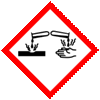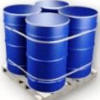| Anmol Chemicals is the pioneer manufacturers of Caustic Soda, Sodium Hydroxide & Caustic Potash, Potassium Hydroxide Pellets, Pharmaceutical Excipients Fragrance Food & Flavor chemicals in India. We offer Halal and Kosher Caustic Soda, Sodium Hydroxide & Caustic Potash, Potassium Hydroxide Pellets made in an ISO9001, ISO22000 (FSSC22000) cGMP and GLP certified facility. Our group has several manufacturing facilities spread across the world, supported by toll manufacturers and representatives in UAE, Europe, Africa, USA, China and has several associated manufacturing facilities spread across India. All the Information on Physics, Chemistry, Applications, Uses and Technology on Manufacture of Caustic Soda, Sodium Hydroxide & Caustic Potash, Potassium Hydroxide Pellets is in these pages. |
| The units have one or more of the certifications like FDA GMP, ISO 9001, ISO 22000, HACCP, REACH, Kosher & Halal |
Sodium Hydroxide Caustic Soda SDS GHS, MSDS Sheet
Sodium Hydroxide, Caustic Soda Pellets BP USP NF ACS Analytical
Reagent FCC Food Grade Manufacturers
Potassium Hydroxide Caustic Potash Pellets BP USP NF ACS Analytical
Reagent FCC Food Grade Manufacturers
Sodium Hydroxide SDS GHS, MSDS Sheet, Material Safety Data Sheet
Section 1: Product Identification
Synonyms: Caustic Soda or Sodium Hydroxide Solid, Flakes, Pellets.
CAS No.: 1310-73-2
EINECS EC Number: 215-185-5
Molecular Weight: 40.00
Chemical Formula: NaOH
Relevant identified uses of the substance or mixture and uses advised against: Laboratory chemicals, Manufacture of substances. For Industrial use.
Details of the supplier of the safety data sheet: As per letter head.
Section 2: Hazard Identification
GHS, Globally Harmonized System Classification in accordance with 29 CFR 1910
Classification according to Regulation (EC) No 1272/2008
Corrosive to Metals Category 1
Skin corrosion/irritation Category 1A, B, C
Hazardous to the aquatic environment, acute hazard Category 3
Labeling according Regulation (EC) No 1272/2008
| GHS Label Elements  Corrosive |
Signal Words: Danger
Hazard statements:
H290: May be corrosive to metals
H314: Causes severe skin burns and eye damage
H402: Harmful to aquatic life
Precautionary statements:
P234: Keep only in original container.
P260: Do not breathe dust/fume/gas/mist/vapors/spray.
P264: Wash … thoroughly after handling.
P273: Avoid release to the environment.
P280: Wear protective gloves/protective clothing/eye protection/face protection.
P312: Call a POISON CENTER or doctor/physician if you feel unwell.
P362: Take off contaminated clothing and wash before reuse.
P301+330+331: IF SWALLOWED: Rinse mouth. Do NOT induce vomiting.
P303+361+353: IF ON SKIN (or hair): Remove/Take off immediately all contaminated clothing. Rinse skin with water/shower.
P305+351+338: IF IN EYES: Rinse cautiously with water for several minutes. Remove contact lenses if present and easy to do – continue rinsing.
P390: Absorb spillage to prevent material damage.
P404: Store in a closed container.
P405: Store locked up.
P501: Dispose of contents/container to authorized agents only.
Classification according to EU Directives 67/548/EEC or 1999/45/EC:

C Corrosive
R35 Causes severe burns.
Section 3: Composition / Information on Ingredients
Ingredient: Sodium Hydroxide Pellets
CAS No.: 1310-73-2
EINECS EC Number: 215-185-5
Percent: 99 - 100%
Section 4: First Aid Measures
Always seek medical attention after first aid measures are provided.
Eye Contact: Check for and remove any contact lenses. In case of contact, immediately flush eye with plenty of water for at least 15 minutes. Cold water may be used. Get medical attention immediately.
Skin Contact: Immediately flush skin with plenty of water for at least 15 minutes while removing contaminated clothing and shoes. Call a physician, immediately. Wash clothing before reuse..
Ingestion: If swallowed, do not induce vomiting unless directed to do so by medical personnel. Never give anything by mouth to and unconscious person. Loosen tight clothing such as a collar, tie, belt or waistband. Get medical attention immediately.
Medical Conditions generally Aggravated by Exposure: Repeated exposure of the eyes to a low level of Sodium hydroxide dust can produce eye irritation. Repeated skin exposure can produce local skin destruction, or dermatitis. Repeated inhalation of dust can produce varying degree of respiratory irritation or lung damage.
Section 5: Fire Fighting Measures
Flash Point: NA
Fire Extinguishing Media: Adapt extinguishing media to the environment. Use water spray, alcohol-resistant foam, dry chemical or carbon dioxide.
Special Fire Fighting Procedures: Wear self contained breathing apparatus for firefighting if necessary.
Unusual Fire and Explosion Hazards: Flammable hydrogen gas may be produced on prolong contact with metals such as aluminum, tin lead and zinc.
Hazardous combustion products: Oxides of sodium.
Section 6: Accidental Release Measures
Steps to be Taken in Case Material is Released or Spilled: Evacuate the area of all unnecessary personnel. Wear suitable protective equipment. Eliminate any ignition sources until the area is determined to be free from explosion or fire hazards. Contain the release and eliminate its source, if this can be done without risk. Take up and containerize for proper disposal. Comply with local, state and Federal regulations on reporting releases. Refer to regulatory information for reportable quantity and other regulatory data.
Methods for cleaning up: Take up liquid spill into absorbent material, e.g.: dry sand/earth or powdered limestone. Scoop absorbed substance into closing containers. Carefully collect the spill/leftovers. Small quantities of liquid spill may be neutralize with acid solution. Wash away neutralized product with plentiful water. Clean contaminated surfaces with an excess of water. Take collected spill to manufacturer/competent authority. Wash clothing and equipment after handling.
Waste Disposal Methods: Dispose of waste according to Federal, State and Local Regulations.
Section 7: Handling and Storage
Keep Sodium hydroxide Pellets in a tightly closed original container. Protect from physical damage. Store in a cool, dry, ventilated area away from sources of heat, moisture and incompatibilities. Always add the caustic to water while stirring; never the reverse. Containers of Sodium hydroxide may be hazardous when empty since they retain product residues (dust, solids); observe all warnings and precautions listed for the product. Do not store with aluminum or magnesium. Do not mix with acids or organic materials.
Section 8: Exposure Controls / Personal Protection
Components with workplace control parameters
Derived No Effect Level (DNEL)
Application Area: Workers, Consumers
Exposure routes: Inhalation
Health effect Long-term local effects: 1 mg/m3
USA ACGIH: 2 mg/m³ ACGIH Ceiling (mg/m³)
USA OSHA: 2 mg/m³ OSHA PEL (TWA) (mg/m³)
British Columbia: 2 mg/m³ OEL Ceiling (mg/m³)
Engineering Controls Ventilation required: Sodium hydroxide should be handled or transferred in an approved fume hood or with adequate ventilation.
Personal Protection Equipment
Respiratory protection: If workplace exposure limit (s) of product or any component is exceeded (see TLV/PEL), a NIOSH/MSHA approved air supplied respirator is advised in absence of proper environmental control. OSHA regulations also permit other NIOSH/MSHA respirator (negative pressure type) under specified conditions (see your safety equipment supplier). Engineering and/or administrative controls should be implemented to reduce exposure.
Protective gloves: Nitrile or equivalent.
Skin protection: Impervious, protective clothing.
Eye protection: Safety glasses with side shields must be worn at all times.
Additional clothing and/or equipment: Eyewash and safety equipment should be readily available.
Handle in accordance with good industrial hygiene and safety practice. Wash hands before breaks and at the end of workday.
Section 9 Physical and Chemical Properties
Appearance and Physical State: Sodium hydroxide is white Solid (flakes, pellets or granular)
Odor (threshold): Odorless.
Specific Gravity (H2O=1): 2.13
Vapor Pressure (mm Hg): NA
Vapor Density (air=1): NA
Melting Point: 318C (604F)
Boiling Point: 1390.04C (2534.1F)
Freezing point / melting point: 318.38C (605.1F)
pH: 13-14 at 50gm/liter
Solubility in Water: Soluble
Section 10: Stability and Reactivity
Stability: Sodium hydroxide is stable under ordinary conditions of use and storage. Very hygroscopic. Absorbs atmospheric CO2.
Reactivity: Exothermic reaction with water. Violent exothermic reaction with strong acids. Reacts with some metals to release hydrogen.
Conditions to Avoid: Contact with moisture may generate sufficient heat to ignite surrounding combustible material.
Materials to Avoid (Incompatibility): Water, acids, chlorinated hydrocarbons, oxidizing agents, metals and organic materials.
Hazardous Decomposition Products: None indicated.
Hazardous Polymerization: Will not occur.
Section 11: Toxicological Information
Results of component toxicity test performed:
1350 mg/kg skin-rabbit LD50;
104-340 mg/kg oral-rat LD50;
40 mg/kg intra peritoneal-mouse
LD50; 500 mg/kg oral-rabbit LDLo
This product is not classifiable as to its carcinogenicity based on its IARC, ACGIH, NTP, or EPA classification.
Tests on laboratory animals indicate material may produce adverse mutagenic effects.
Human experience: Extremely hazardous in case of eye contact ( corrosive). Causes severe eye burns. Extremely hazardous in case of skin contact (corrosive). Skin contact produces severe burns. Hazardous in case of skin contact (permeator). Extremely hazardous in case of inhalation (lung corrosive). Hazardous in case of inhalation. Extremely hazardous in case of ingestion. May be fatal if swallowed. This product does not contain any compounds listed by NTP or IARC or regulated by OSHA as a carcinogen.
Section 12: Ecological Information
Toxicity to fish:
LC50 - Gambusia affinis (Mosquito fish) - 125 mg/l - 96 h
LC50 - Oncorhynchus mykiss (rainbow trout) - 45,4 mg/l - 96 h
Toxicity to daphnia and other aquatic invertebrates: Immobilization EC50 - Daphnia - 40,38 mg/l - 48 h
This substance does not meet the criteria for classification as PBT or vPvB.
Section 13 Disposal Considerations
RCRA 40 CFR 261 Classification: Material does not have an EPA Waste Number and is not a listed waste. Federal, State and local laws governing disposal of materials can differ. Ensure proper disposal compliance with proper authorities before disposal.
Section 14: Transportation Information
US DOT Information:
Proper shipping name: Sodium Hydroxide, solid
Hazard Class: 8
Packaging group: II
UN Number: UN1823
IATA:
Proper shipping name: Sodium Hydroxide, solid
Hazard Class: 8
Packing group: II
UN Number: UN1823
IMO:
Proper shipping name: Sodium Hydroxide, solid
Class: 8
UN Number: UN1823
Packing group: II
EMS: ND
MFAG: ND
Marine Pollutant: No
Canadian TDG: ND
ADR/RID:
UN Number: 1823
Description of the goods: Sodium Hydroxide
Packaging group: II
Hazard identification No: 80
Hazard label: 8
Environmentally Hazardous: No
Section 15: Regulatory Information
USA:
OSHA: Hazardous by definition of Hazard Communication Standard (29 CFR 1910.1200).
SARA: 302/304/311/312 extremely hazardous substances: No products were found.
SARA Title III: 302/304 emergency planning and notification: No products were found.
RCRA: Material does not have an EPA Waste Number and is not a listed waste.
TSCA 8(b) inventory: Sodium Hydroxide
CERCLA: 1000 lbs.
California Proposition 65: None
HMIS (Perceived): Health Hazard: 3, Fire Hazard: 0, Reactivity: 2, Personal Protection: J
NFPA (Perceived): Health: 3, Flammability: 0, Reactivity: 1
Canada WHMIS: CLASS E: Corrosive solid.
EINECS EC Number: 215-185-5
DSCL (EEC):
R35- Causes severe burns. S26- In case of contact with eyes, rinse immediately with plenty of water and seek medical advice.
S37/39- Wear suitable gloves and eye/face protection. S45- In case of accident or if you feel unwell, seek medical advice immediately (show the label where possible).
Section 16: Other Information
C Corrosive
R35 Causes severe burns.
H290: May be corrosive to metals
H314: Causes severe skin burns and eye damage
H402: Harmful to aquatic life
Disclaimer:
******************************
Our company provides this Caustic Soda Sodium hydroxide MSDS information sheet contained herein in good faith but makes no representation as to its comprehensiveness or accuracy. This Sodium Hydroxide MSDS sheet is intended only as a guide to the appropriate precautionary handling of the material by a properly trained person using this product. Individuals receiving the information must exercise their independent judgment in determining its appropriateness for a particular purpose.
******************************
Caustic Soda Sodium Hydroxide Pellets Manufacturer at:
Anmol Chemicals
S-8, SARIFA MANSION, 2ND FLANK ROAD, CHINCHBUNDER, MUMBAI 400009, INDIA
TEL: (OFFICE) 91-22-23770100, 23726950, 23774610, 23723564 - FAX: 91-22-23728264
e-mail: anmolc@mtnl.net.in

Exports to USA, Canada, UAE, Dubai, South Africa, Tanzania, Kenya, Nigeria, Egypt, Uganda, Turkey, Mexico, Brazil, Chile, Argentina, Europe Netherlands, Italy, Spain, Germany, Portugal, France, Malaysia, Indonesia, Thailand, Korea, Japan, etc.
Copyright and Usual Disclaimer is Applicable. 17 February, 2022
If you want your work to be done well, then go to a busy man.
The other one has no time.
Sodium hydroxide pellets, Potassium hydroxide pellets manufacturers




